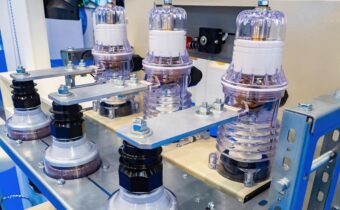
Editorial message
Spotlight: Recruiting engineering talent Industry experts are increasingly sounding the alarm about a growing talent crisis in substation engineering. In this issue, we feature candid...

Spotlight: Recruiting engineering talent
Industry experts are increasingly sounding the alarm about a growing talent crisis in substation engineering. In this issue, we feature candid insights from leading professionals—Bram Smits, Sabine Erlinghagen, and Gaurav Joshi—on the skills and technologies essential to the field. Additionally, René Smeets explores the interdisciplinary expertise required to excel in this industry.
Data from Transformers Magazine and Industry Navigator indicate that power system manufacturers consider the engineering talent gap to be the most pressing challenge in the industry today [1].
For young engineers navigating an uncertain world, job security is fragile. However, switchgear engineering is a field where expertise is in steady demand, playing a vital role in global infrastructure. Even more importantly, engineers working in this space develop future-proof skills.
This issue: Technologies transforming power systems
The extreme environmental conditions which power substations are subjected to make reliability an evergreen concern. As climate change accelerates, Marius Grisaru examines the impact of extreme temperature fluctuations on conductors, insulators, and semiconductors. His article highlights the importance of thermal management and material selection in ensuring grid resilience.
The push toward SF6-free technology is reaching a tipping point. Hassan Zaheer and Saifa Khalid from PTR Inc. analyse rapid advancements in SF6-free gas-insulated switchgear (GIS) and explore how regulatory shifts and technological breakthroughs are reshaping the industry.
Meanwhile, our fundamentals series introduces circuit-breaking technology. Gaurav Joshi explains the working principles of Vacuum Circuit Breakers (VCBs)—a compact, robust, and environmentally friendly alternative to F-gases.
AI’s power demand: The grid’s latest challenge
As AI revolutionizes arts and sciences, its insatiable demand for power is forcing new investments in grid infrastructure. John Wanjiku explores the staggering energy and cooling needs of AI data centres, whose consumption now rivals that of entire cities. This rapid growth is accelerating investment in grid modernization.
But beyond its massive energy footprint, AI is also reshaping power systems themselves.
AI authored article and aftermath
AI is already transforming the power sector:
Load forecasting & grid optimization – High-dimensional machine learning algorithms dynamically forecast consumption and allocate generation units.
Digital twins & predictive maintenance – Virtual models of substations enable real-time diagnostics and failure prevention.
Autonomous energy systems – AI-driven microgrids self-adjust to optimize efficiency.
More broadly, AI’s most immediate impacts have been in data management and technical writing. In the spirit of adopting new technologies, I conducted an experiment: using AI tools to generate an article for Switchgear Magazine (see “Grid Operators in the Age of Autonomous Energy Systems” and the accompanying “AI Article Rejected”).
The result? While the AI-generated text appeared technically sound, peer review exposed critical flaws. AI struggled with real data sources, relied on speculative claims, and lacked structural coherence.
The ability of AI to create convincing-looking yet flawed content poses ethical challenges for technical publications. AI-generated misinformation may slip through review processes, misleading readers.
AI Policy:
The AI-generated article violated all three criteria below, but going forward Switchgear Magazine will align its AI authorship policy with the IEEE Position Statement [2]:
Acknowledgment of AI assistance is mandatory.
Human accountability for content remains essential.
AI-generated text cannot be used without verification and editorial oversight.
While AI is a powerful tool, it cannot (yet) match human expertise in technical validation and critical thinking.
Looking ahead: AI’s role in industry and society
My experiment highlighted the ethical challenges of AI authorship in technical publications. The case of Guo et al.’s retraction last year [3] is a stark reminder: AI-generated content can appear credible while containing fundamental errors that evade immediate detection.
This study underscores the current limitations of AI in technical writing. But looking ahead, the most important takeaway is not AI’s shortcomings relative to human writers—it’s the fact that AI can generate meaningful content at all.
Nevertheless, like Moore’s Law, AI’s progress has been exponential, doubling annually [4]. As shown in Figure (a), from today’s perspective the computation to train AI might as well have been zero in the year 2000. However, back in 2000 it would have appeared that magnitudes had “turned the knee” (Figure (b)).
Claude Shannon’s electromechanical mouse, Theseus, was groundbreaking with the training equivalent of 10-12 petaFLOP* in 1950. Large Language Models are trained at a cumulative 1010 petaFLOPs and up today.**
AI turned the knee of exponential growth in the last two years in the sense that ChatGPT-3 ushered AI into the zeitgeist. Now AI is reshaping fields once thought untouchable, from matchmaking to engineering.
To give an anecdote, consider that just a few years ago, the idea of robots evaluating individuals and selecting mates seemed absurd. Today, AI matchmakers are commonplace. Likewise, AI-driven power grids and autonomous energy management systems may soon be the norm.
The key takeaway isn’t the flaws of today’s AI – it’s the inevitability of its advancement. AI is far from static. If its exponential growth continues (Figure (c)), imagine AI systems 1,000 times more powerful within a decade.
As we enter this new era, Switchgear Magazine will continue exploring the evolving relationship between power systems, engineering talent, and artificial intelligence.
Acknowledgements
My custom trained GPT at OpenAI edited this article.
Douglas Maly
Editor-in-Chief
Switchgear Magazine
References
[1] M. Banovic and A. Banovic, Investments 2024 – Outlook to 2033. Merit Media International, 2024.
[2] IEEE-USA Artificial Intelligence & Autonomous Systems Policy Committee, “Accelerating Inclusive Innovation by Building Trust,” IEEE-USA, Washington, D.C., July 2020.
[3] X. Guo, L. Dong, and D. Hao, “RETRACTED: Cellular functions of spermatogonial stem cells in relation to JAK/STAT signaling pathway,” Frontiers in Cell and Developmental Biology, vol. 11, Feb. 2024, Art. no. 1339390, doi: 10.3389/fcell.2023.1339390.
[4] Our World in Data, “Computation used to train notable artificial intelligence systems, by domain,” [Online]. Available: https://ourworldindata.org/grapher/artificial-intelligence-training-computation.





